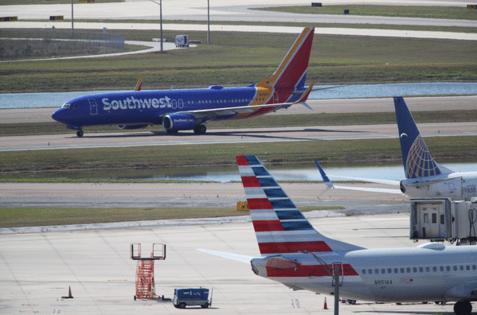Florida airports ordered to report any 'weather modification' activities
Published in News & Features
Florida airports soon must submit monthly reports on weather modification activities or face the loss of state funding under a controversial new law derided by critics as fueling conspiracy theories.
Florida Attorney General James Uthmeier wrote to operators of public airports on Monday that their compliance is needed to “catch those who seek to weaponize science” and will safeguard the atmosphere from “harmful chemicals and experiments.”
“We need your help to keep our state free and make sure the skies belong to the people —not to private contractors, corporate experiments, or climate extremists,” he wrote. “In Florida, we don’t jeopardize the public health so that we can bend the knee to the climate cult.”
Signed by Gov. Ron DeSantis in June, the law prohibits the release of any substance into the atmosphere in Florida that seeks to “alter weather, temperature, climate, or sunlight intensity.”
Critics, though, say state officials are seeking to address a nonexistent problem and burdening airports with an unproductive mandate. Among the conspiracy theories is the longstanding notion that aircraft condensation trails are actually “chemtrails,” consisting of chemical agents sprayed for nefarious purposes.
“This bill is crazy to me,” said state Rep. Ashley Gantt, D-Miami, as the legislation was debated earlier this year. “We’re asking in this bill to do something that is not happening in Florida,” she said. “There’s a phrase … ‘Go outside and touch some grass.’ We need to get grounded.”
Florida previously required a license to engage in weather modification efforts. But the Florida Department of Environmental Protection has never issued such a license or even received an application for one since that program was created in 1957, according to an agency spokeswoman.
Orlando International Airport and Orlando Executive Airport received the attorney general’s letter and will comply with the new reporting requirements, said Angela Starke, a spokeswoman for the Greater Orlando Aviation Authority, which operates the airports.
“Neither airport performs any geoengineering or weather modification activities, nor are we are aware of any activity on airport properties that must be reported at this time,” she wrote in an email.
Officials with Orlando Sanford International Airport also said they will comply with the law and aren’t aware of any such activities.
Under the new law, airports must report the presence of any aircraft equipped with devices or components that release substances or chemicals into the atmosphere for the “express purpose of affecting temperature, weather, climate, or the intensity of sunlight.”
Starting in October, monthly reports must be filed with the Florida Department of Transportation.
Additionally, the Department of Environmental Protection is launching a portal for the public to report suspected violations. Supporters of the law have been critical of research into geoengineering, large-scale interventions into the Earth’s climate that could potentially be used to mitigate climate change.
The weather modification ban drew opposition from Augustus Doricko, CEO and founder of the cloud seeding startup Rainmaker Technology Corp. He testified to lawmakers that cloud seeding is not occurring in Florida but could be a safe and effective water supply tool.
In the letter to airports, Uthmeier wrote that he thinks weather modification could have played a role in the Texas floods that killed more than 100 people over the Fourth of July weekend.
An Associated Press investigation, however, found no evidence that weather modification caused the deadly flood. Andrew Dessler, director of Texas A&M University’s Texas Center for Extreme Weather, called such a claim “complete nonsense.”
Social media-fueled conspiracy theories prompted the National Oceanic and Atmospheric Administration to issue a statement in October that it does “not modify the weather, nor does it fund, participate in or oversee cloud seeding or any other weather modification activities,”
Between 1962 and 1982, NOAA supported research into whether hurricane intensity could be modified, known as Project STORMFURY, according to the statement.
The research was not successful, and the project was discontinued, federal officials said.
_____
©2025 Orlando Sentinel. Visit orlandosentinel.com. Distributed by Tribune Content Agency, LLC.







Comments